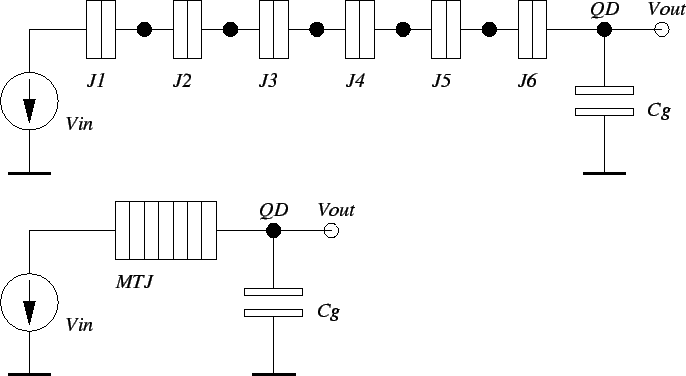



Next: 5.2.8 Ring Memory
Up: 5.2 Single Electron Memories
Previous: 5.2.6 Single Electron Flip
5.2.7 Multi Tunnel Junction Memory
K. Nakazato and H. Ahmed [88] proposed
a dynamic memory cell pushed to its extreme limit. A small
number of electrons is stored on a single quantum dot. Their presence
on the quantum dot QD corresponds to logical '1' and their absence to '0'
(see Fig. 5.8).
Figure 5.8:
Circuit diagram of the multi-tunnel-junction memory cell.
 |
To write in this cell a voltage pulse is applied
(
 ). A positive pulse
). A positive pulse
 forces electrons to
tunnel through junctions J6, J5,..., J1 off of quantum dot QD.
A negative voltage pulse
forces electrons to
tunnel through junctions J6, J5,..., J1 off of quantum dot QD.
A negative voltage pulse
 forces electrons to tunnel onto QD.
The state of the memory dot QD is sensed at
forces electrons to tunnel onto QD.
The state of the memory dot QD is sensed at
 .
The central
island of a SET transistor which is extremely charge sensitive, may be used
as sensor for the logic states. However exactly this charge sensitivity
makes these devices prone to random background charge. The more tunnel
junctions are used the less likely it is that electrons are co-tunneling to ground.
That is why this memory is a dynamic memory, since the charges can not
be trapped infinitely. Nevertheless, the refresh rate can easily extend to the
second or minute range.
At least two tunnel junctions are needed to achieve a memory effect.
We have chosen the multi-tunnel-junction (MTJ) memory to consist of six tunnel
junctions, so that flip-flop, MTJ memory and ring memory have the same number
of junctions and are better comparable.
.
The central
island of a SET transistor which is extremely charge sensitive, may be used
as sensor for the logic states. However exactly this charge sensitivity
makes these devices prone to random background charge. The more tunnel
junctions are used the less likely it is that electrons are co-tunneling to ground.
That is why this memory is a dynamic memory, since the charges can not
be trapped infinitely. Nevertheless, the refresh rate can easily extend to the
second or minute range.
At least two tunnel junctions are needed to achieve a memory effect.
We have chosen the multi-tunnel-junction (MTJ) memory to consist of six tunnel
junctions, so that flip-flop, MTJ memory and ring memory have the same number
of junctions and are better comparable.
Recently S. Amakawa et al. [2] proposed a MTJ memory with
improved persistence to co-tunneling (see Fig. 5.9).
Figure 5.9:
Circuit diagram of the dual-array multi-tunnel-junction memory
cell.
 |
Instead of trapping only electrons, they suggested to trap electrons and
holes on separate quantum dots which are coupled by a capacitor Cc. This
could be called an exciton trap. Increasing Cc increases the coupling
between
electrons and holes, but also increases the island capacitances and thus
reduces the Coulomb blockade and operation temperature. The additional binding of the
exciton makes it more resistant to co-tunneling with the same number of
tunnel junctions.




Next: 5.2.8 Ring Memory
Up: 5.2 Single Electron Memories
Previous: 5.2.6 Single Electron Flip
Christoph Wasshuber
